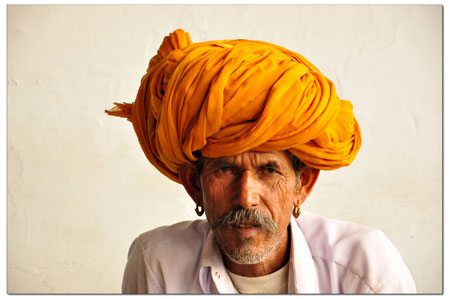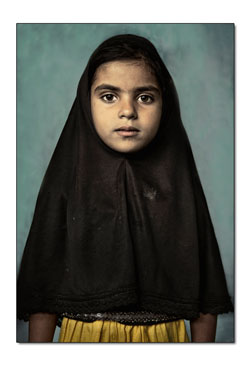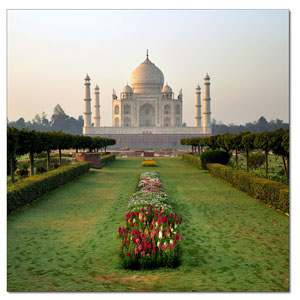 |
| A turbaned man poses for a photo for a local photographer on a recent trip to India. Local photographers joined renowned photographer Steve McCurry on the two-week trip, and the results will be on display at the Open Shutter next week./Photos, above and below, by Brandon Donahue |
Passage to India
Photographers join Steve McCurry on a journey of discovery
by Stew Mosberg
Renowned photojournalist Steve McCurry has exhibited at the Open Shutter Gallery several times, and that’s how gallery manager Brandon Donahue first came to meet him. McCurry’s body of work includes some of the most famous photographic images ever reproduced. Other than his visual reportage of war-ravaged countries, his most familiar work is that of exotic people and places.
Renowned photojournalist Steve McCurry has exhibited at the Open Shutter Gallery several times, and that’s how gallery manager Brandon Donahue first came to meet him. McCurry’s body of work includes some of the most famous photographic images ever reproduced. Other than his visual reportage of war-ravaged countries, his most familiar work is that of exotic people and places.
To have an opportunity to tag along on one of McCurry’s journey’s, to photograph alongside him, and to learn from him while doing so, has to be a photographer’s dream. For Donahue and six others, that dream recently became a reality.
Donahue was already friends with McGregor and Olivier Borson, while Rodrigo Frota and Jon Kaplan had been on a prior McCurry journey with McGregor, Borson and Heidi Lender.
 |
| A portrait of a young Indian girl, one of the many photos that will be on display at the Open Shutter’s “Looking East” exhibit, which runs through July./Photo by Suzi McGregor |
The resulting images taken by the seven artists are being exhibited at the Open Shutter in a show titled “Looking East,” along with equally compelling photographs by gallery owner Margy Dudley, taken during her own foreign excursions.
For Donahue, visiting India, particularly Rajasthan, was a monumental personal and professional experience. “Everybody on the expedition was there for the purpose of photography,” he said. “There was time to explore on your own, and you were free to pursue any subject you’d like, but we were all there to photograph India.”
In trying to describe it for those who have never been there, Donahue said one really has to go to India to understand it. “It’s not just another country; it’s another universe,” he said. “The people were so kind and generous. Everybody greeted you and smiled and I was humbled again and again by how friendly they were and how eager they were to share India with me.”
Although verbally difficult to describe, photographs taken by the group provide a glimpse into the exotic, esoteric, enigmatic world of the East and its dense environs. The workshop was less than two weeks in length, and Borson and Donahue arrived a few days early to explore on their own. “Each day in India feels like three days,” said Donahue, “There are three times as many smells, colors, people, (and) things to look at; things to do.”
The group spent every day together and each had one-on-one time with McCurry whenever they felt the need for guidance.
“Going to Rajasthan can be a difficult excursion, especially when visiting the smaller villages; services are minimal and a needy person would not do well,” says McGregor. “It also helps to have a sense of humor, (particularly) about yourself.”
McGregor has spent the last 25 years documenting the world through her lens. Her work has appeared in the New York Times, Newsweek, Time, Audubon, Sierra, Wilderness, and various other highly regarded newspapers and magazines. She is also author of Under the Sun, and the co-author of Living Homes: Sustainable Architecture and Design, and was photographer for the Southern Ute Cultural Center and Museum.
Equally accomplished and acclaimed, Heidi Lender is another talented photographer with a fascinating background. Her beguiling photographic essay about women’s’ roles was recently featured in a two-person show at Open Shutter. She is currently having her first solo show in Atlanta. Lender first met McCurry during a workshop in India two years ago.
Olivier Borson exhibited at Open Shutter’s juried show last year, yet resides in an exotic locale of his own; Reunion Island, a French overseas territory near Mauritius. Borson met McCurry three years ago, during a workshop in India. Explaining his reason for signing up again he said, “I choose his workshops because I was always fascinated by his work; colors; composition; and I wanted to see how a great professional like him worked.”
This time around Borson had a particularly enlightening experience, “I realized that photography is very difficult and challenging work. You have to be concentrated all the time, focusing your attention on everything, to see the details of life and capture a great moment or action. Steve is a real master of this.”
Delving into why this excursion differed from the others, Borson remarked that he found it more demanding. “We had to photograph everyday life in Rajastan: anonymous people, craftsmen, everyone who (is) living, eating and working in the streets, (and) also the life in the farm lands: the shepherds, the farmers, their families,” he says. “That’s why it was very challenging. You (had) to find the interesting details, the uncommon action, the funny situation that can make your photos interesting, different from a touristic (sic) review.”
Another geographically distinctive member of the group is Rodrigo Queiroz Frota of Brazil. He, too, has been on previous journeys with McCurry, but agrees that this one was special because of his easy access to Steve and also how well they all worked together. “The whole group moved differently than (my) last time,” he acknowledged, “We weren’t in a rush all the time, so we could work our ideas better.”
Although Frota’s photographs are regularly exhibited in South America, this show will give locals a chance to experience his talent first hand.
This is an intriguing exhibition, as much for its artistic merit as it is the panoply of the humanity it portrays. The work is exquisite and mesmerizing to look at, and while one cannot smell, taste or hear what is taking place in the image, a viewer’s senses are sure to be peaked.
This is an intriguing exhibition, as much for its artistic merit as it is the panoply of the humanity it portrays. The work is exquisite and mesmerizing to look at, and while one cannot smell, taste or hear what is taking place in the image, a viewer’s senses are sure to be peaked.
 |
| The Taj Mahal in full bloom./Photo by Brandon Donahue |
